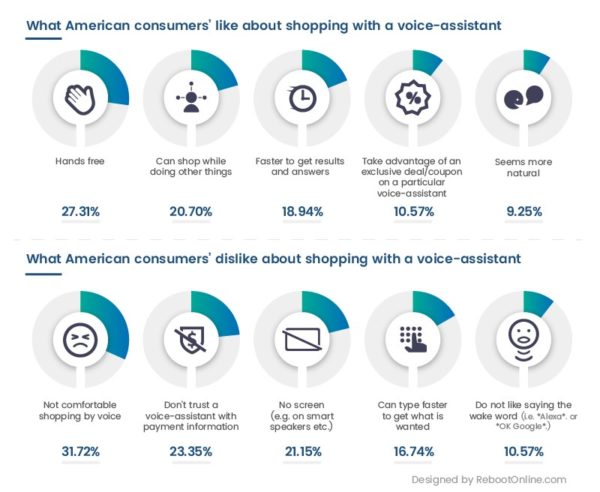Connected devices (i.e., the Internet of Things) increasingly affect our lives – from a car’s navigation providing the quickest route to meet a friend, to your smart watch telling you it’s time to stand. In a previous post we highlighted Five Things You Need to Know About the Internet of Things – including what it is and where it’s going. In this post we’ll explore a growing phenomenon in the world of connected devices – voice assistants.
Think voice and digital for voice assistant. While many consumers ask Alexa or Siri about the weather or to play their favorite tunes, a growing number are using voice assistants to shop. If you’re skeptical about the role of voice assistants in the shopping experience, consider this estimate from OC&C management strategy consultants: “$40 billion will be spent on U.S. voice commerce by 2022.”
Almost 25% of American households own a smart speaker.
Source: Nielsen study
Given voice assistants’ expected influence on shopping, the online marketplace OnBuy.com, wanted to learn more about them. To gain insight into consumers’ attitudes and their buying habits when using voice assistants, the company analyzed responses of 1,203 consumers surveyed by VoiceBot.AI. Results are provided below.
Purchases through a voice-assistant
What did American consumers order most through voice-assistants? It was everyday household items, such as cleaning products. Next was clothing and entertainment. In contrast, Americans were least likely to use voice-assistants to find hair cutters, dry cleaners and other local services.
Attitudes toward shopping with a voice assistant
Consumers most liked the hands-free feature of voice assistants. They also appreciated that they could do other things while making a purchase. However, about one-third were not comfortable with voice shopping and almost one-quarter were concerned about the safety of their personal information when using a voice assistant. Additional challenges were the lack of a screen and consumers’ perception that they could get what they want faster by typing.

An integrated in-store experience is on the horizon
As the use of voice assistants for shopping becomes more common, OnBuy.com gives us insights into consumer preferences. While in a store, they want help locating products, notification of discounts and deals, and comparisons between products such as the nutritional value of ingredients.
“We can see a world where voice is embedded into everyday devices such as wearables, appliances and vehicles. With the continued integration and improvements behind machine learning and natural language processing, we have every reason to believe we will see a convergence of voice shopping with the internet of things, augmented reality and other emerging technologies. Consumers will be able to – and expect to – talk to almost anything.”
Source: Tiffany Tan Kohler, Director, brand engagement commerce, The Clorox Co.
Retailers can also enhance the shopping experience by using connected devices to provide relevant offers or identify where to place popular products in the store. For examples of what businesses might do to engage customers, provide added value and personalize offerings, see our blogs, 4 Ways the Internet of Things is Transforming Customer Experience and IOT Will Change the Future of Marketing.
What’s next for voice shopping
Voice-assistants and other connected devices are changing shoppers’ behaviors and expectations. Whether more consumers turn to voice-assistants for a wider range of purchases throughout the day, the use of voice assistants is expected to expand and evolve.
“Alexa, what’s the best price for Tide?” How voice-assistants are helping us shop, via @beyondthearc http://bit.ly/2TX9oot #AI #IoT #cx (Click to Tweet!)
#
Looking to stay ahead of digital disruption in your industry? Let’s talk!

